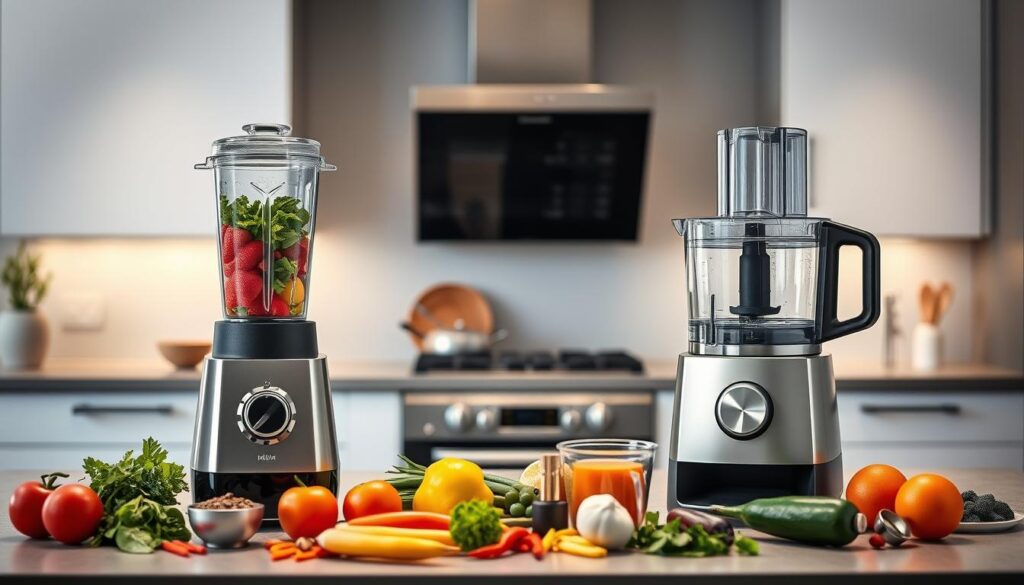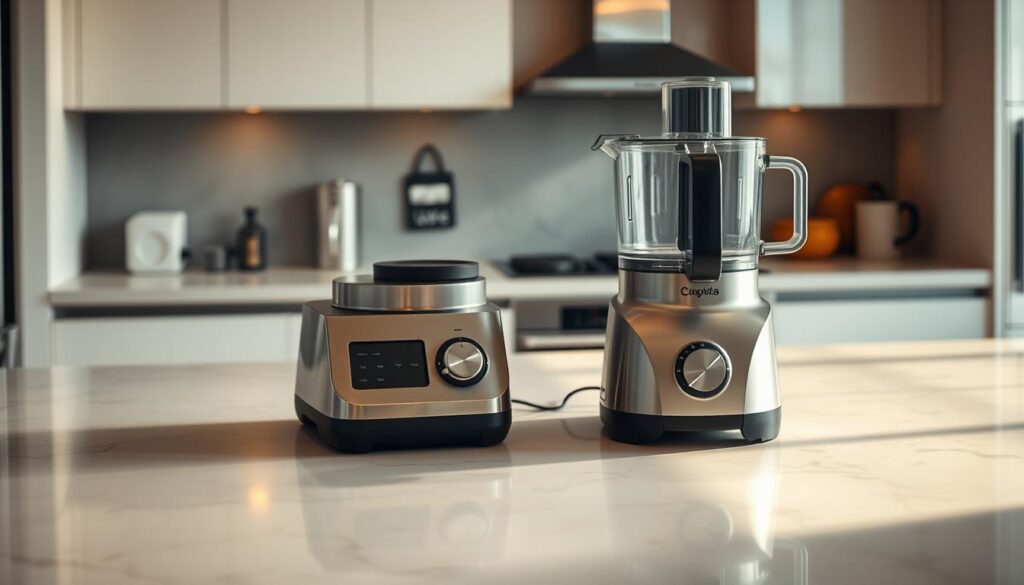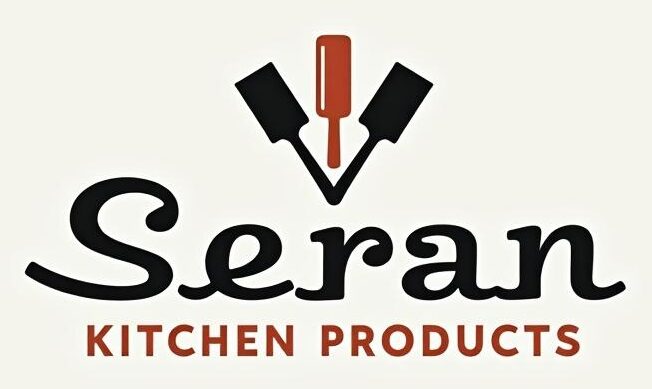The kitchen is more than just a place to cook. It’s where creativity and nourishment meet. But, deciding between a blender and a food processor can be tough. Each has its own strengths, and knowing them can make a big difference in your cooking.
Choosing the right tool can make cooking at home easier and more enjoyable. It’s not just about picking a kitchen appliance. It’s about finding the perfect match for your cooking style. Are you ready to find out which one is best for you?
Key Takeaways
- Understanding the unique functionalities of each appliance is key.
- A blender is great for smoothies and liquid recipes.
- A food processor is perfect for chopping, slicing, and dough.
- Think about your cooking habits and space when deciding.
- The price can also play a big role in your choice.
Introduction to Kitchen Appliances
Kitchen appliances have changed how we prepare food, making it easier and more fun. Gadgets like blenders and food processors are key in today’s kitchens. They help with tasks like chopping, mixing, blending, and pureeing.
Using the right tools can make cooking faster and more efficient. For example, a good blender makes smoothies and soups easy. A food processor can slice veggies or mix dough, saving time and boosting creativity.
Adding modern kitchen appliances to your routine makes cooking more enjoyable. With the right tools, anyone can make tasty meals at home. Investing in quality gadgets can change how we cook, making it easier to try new recipes.
Understanding Blenders and Their Benefits
Blenders are key kitchen tools that bring many blender benefits thanks to blending technology. They are great for making liquid-based recipes. They can puree ingredients, crush ice, and mix things together smoothly. This makes them perfect for cooking and making drinks at home or in a professional kitchen.
Main Functions of a Blender
Knowing what a blender can do shows how important it is in the kitchen:
- Pureeing fruits and vegetables for smoothies or soups.
- Crushing ice for frozen drinks or cocktails.
- Emulsifying dressings and sauces for better flavor.
- Mixing ingredients for batters or doughs.
Common Blending Recipes
Blenders are used in many common blending recipes. They play a big part in healthy cooking:
- Smoothies made from fresh fruits and leafy greens.
- Silky soups like tomato basil or butternut squash.
- Nut butters, including almond or peanut.
- Homemade salad dressings, such as vinaigrettes.
Exploring Food Processors and Their Advantages
Food processors are key kitchen tools known for their versatility and efficiency. They make meal prep easier. These machines handle tasks like chopping veggies and kneading dough.
They can work with both raw and dry ingredients smoothly. This makes them very useful in the kitchen.
Main Functions of a Food Processor
The food processor does more than just chop. It has several important functions:
- Chopping: Great for quickly cutting veggies or fruits.
- Slicing and Shredding: Perfect for cheese, meats, and veggies.
- Kneading Dough: Makes bread and pastry making easier.
- Puréeing: Creates smooth textures for soups and sauces.
Popular Food Processing Recipes
Looking at popular recipes shows how versatile food processors are. Some favorite recipes include:
- Hummus: A creamy dip made with chickpeas and tahini.
- Pesto: A fresh herb sauce with basil, garlic, and nuts.
- Vegetable Preparations: Efficiently slice or shred carrots, zucchini, and more.
Blender vs Food Processor: Which One Should You Get?
Choosing between a blender and a food processor needs careful thought. Each has unique features for different cooking tasks. This section will help you understand the key features and price differences to make a better choice.
Comparison of Features
Blenders are great for smoothies, soups, and liquids because of their sharp blades and strong motors. Food processors are better for chopping veggies, shredding cheese, and making dough. They have more versatility and bigger work bowls. Your cooking habits and needs will guide your choice.
Price Range Considerations
Price is a big factor in your decision. Blenders are usually cheaper than food processors. But, high-end blenders and entry-level food processors can have similar prices. Knowing what you need helps find the best value for your money.
Key Differences Between Blenders and Food Processors
Knowing the mechanical differences between blenders and food processors is key for better cooking. Both are important in the kitchen but serve different roles. This part will look at the main differences, focusing on blade design and capacity.
Blade Design and Functionality
Blenders and food processors have different blade designs. Blenders have fixed blades for blending liquids, perfect for smoothies and soups. Their strong motors make sure the mix is smooth, great for small amounts of liquid and soft foods.
Food processors, on the other hand, have multiple blades. You can chop, dice, and slice with them. They’re great for preparing vegetables or even kneading dough.
Work Bowl vs. Jar Capacities
The size of the work bowl is another important factor. Blenders have jars for blending liquids and soft foods, usually 32 to 72 ounces. This size is perfect for making big batches of smoothies or sauces.
Food processors have larger work bowls, often over 14 cups. This lets you process more food at once. Whether you’re chopping veggies for salads or making dough, it’s a big plus.
| Feature | Blender | Food Processor |
|---|---|---|
| Blade Design | Fixed blades for liquifying | Interchangeable blades for chopping and slicing |
| Primary Function | Blending and pureeing | Chopping, slicing, and shredding |
| Typical Capacities | 32-72 ounces | Up to 14 cups |
| Best Use Cases | Smoothies, soups, and sauces | Vegetable prep, dough making, and nut butters |
Similarities Between Blenders and Food Processors
In a kitchen appliance comparison, blenders and food processors show many similarities. They both have strong motors and containers for food. They also come with different blades or discs for efficient processing.
Even though they’re used differently, these appliances can do similar things. For example, they can both make smooth mixtures. This is useful for making creamy soups or smoothies.
Choosing between a blender or a food processor depends on the recipe. Both can handle emulsification, which is great for sauces or dips. This shows how they can work together in the kitchen.
Knowing their similarities helps when buying kitchen tools. It also opens up more possibilities for cooking at home. Home chefs can use these tools in new ways, improving their cooking experience.
Best Uses for a Blender
A blender is a must-have in every kitchen. It’s great for making liquid recipes. From smoothies to sauces, it makes food taste better and feel smoother.
Liquid Recipes and Smoothies
Blenders are perfect for making smoothies. They mix fruits, veggies, and liquids into a smooth drink. The blades break down tough ingredients, making it silky.
- Fruit Smoothies: Combine bananas, strawberries, and yogurt for a refreshing treat.
- Green Smoothies: Blend spinach, kale, and apple juice for a nutrient-dense option.
- Protein Shakes: Mix protein powder with almond milk and a banana for a post-workout boost.
Emulsifying Sauces and Soups
Blenders are also great for making sauces and soups smooth. They mix ingredients well, making sauces and soups creamy. This is key for many recipes.
- Vinaigrettes: Blend vinegar, oil, and seasonings to create a delicious dressing.
- Tomato Soup: Puree cooked tomatoes, herbs, and broth for a comforting dish.
- Hummus: Blend chickpeas, tahini, lemon juice, and garlic into a creamy spread.
Using a blender for these recipes can really improve your cooking. It makes even simple ingredients taste amazing. This opens up a world of possibilities in the kitchen.
Best Uses for a Food Processor
A food processor is a must-have in many kitchens. It’s great for tasks that need speed and accuracy. Chopping veggies and making nut butters are some of its best uses. Knowing these can help you get the most out of your food processor.
Chopping and Slicing Vegetables
Food processors are top-notch for chopping veggies. They have strong motors and sharp blades. This makes quick work of large amounts, perfect for salads, stir-fries, or soups.
The chopped veggies are all the same size. This is key for even cooking and tasty dishes. Some common veggies include:
- Onions
- Carrots
- Bell peppers
- Celery
Making Dough and Nut Butters
Food processors are also great for dough and nut butters. They’re a big help for home bakers, mixing dough quickly and efficiently. This saves time and ensures a smooth mix.
Making nut butters is easy too. The processor blends nuts into creamy butter without much work. Popular nut butters include:
- Peanut butter
- Almond butter
- Cashew butter
Consumer Preferences: Blender or Food Processor?

When it comes to choosing between a blender or food processor, what people like to cook matters a lot. Many home cooks choose blenders because they’re great for smoothies and soups. But, those who make salads or knead dough often pick food processors.
What people say in reviews shows that each appliance has its own strengths. Blenders are best for blending things into a smooth texture. Food processors, on the other hand, are good for chopping veggies and mixing stuff. This shows that people think about their cooking habits before deciding.
The size of the kitchen and how often you use it can also influence your choice. In small kitchens, a blender that can do many things might be the best choice. But, if you need to handle big batches and different foods, a food processor might be better.
Considerations for Your Kitchen Needs
When buying kitchen appliances, think about a few key things. The space and storage you have can really change how you use your kitchen. Knowing how often you’ll use each appliance helps you choose the right one for your cooking style.
Space and Storage Solutions
Keeping your kitchen organized is important. Blenders and food processors take up different amounts of space. Make sure you have enough room on your countertops and in your cabinets.
Having a special place for these appliances can make your kitchen more efficient. It keeps your tools easy to find and use.
Frequency of Use
Think about how often you’ll use each appliance. If you make smoothies or soups a lot, a blender is a good choice. But if you chop veggies or make dough often, a food processor is better.
Knowing your cooking habits helps you pick the appliance that will make your cooking better.
Recommendations for Top Models
Looking for reliable kitchen appliances? Knowing the best options can really help. This section will show you the top blenders and food processors. They are known for their great performance and lasting quality.
Best Blenders on the Market
The Vitamix A3500 is a top blender. It’s powerful and versatile, making smoothies and hot soups easily. Its strong build means it will last a long time, making it a great kitchen addition.
The Ninja Professional Blender is also a great choice. It’s affordable and performs well. Its strong motor and special blades can crush ice and blend tough ingredients, perfect for health fans.
Top Food Processor Brands
Cuisinart is a top food processor brand. The Cuisinart DFP-14BCNY is a favorite. It has a big work bowl and many attachments for chopping, slicing, and kneading dough.
KitchenAid is known for its beauty and efficiency. The KitchenAid KFP1133 has ExactSlice technology for easy and precise slicing. It’s a stylish and effective choice for your kitchen.
Final Thoughts on Choosing the Right Appliance

Choosing the right kitchen appliance is a journey that involves many factors. It’s about finding what fits your needs best. When comparing blenders and food processors, each has its own benefits.
Think about what you cook most often. If you love making smoothies, a blender is perfect. But, if you’re into chopping and making dough, a food processor is better. This helps you pick the right tool for your kitchen.
Reflecting on your cooking habits makes choosing easier. Whether you’re blending or processing, the right appliance can change your cooking game. It makes cooking more efficient and fun.
Conclusion
As we reach the end, it’s clear that blenders and food processors have their own strengths. Blenders are great for smooth mixes and drinks. On the other hand, food processors are perfect for chopping and making dough.
Think about your cooking habits when choosing a tool. If you make a lot of smoothies or soups, a blender is a good choice. But if you chop or dice food often, a food processor is better. Consider your kitchen space and how often you’ll use these tools.
Choosing the right kitchen gadget depends on what you like and need. Pick the one that fits your cooking style. This way, you’ll enjoy cooking more and get better results.
FAQ
What is the main difference between a blender and a food processor?
Blenders are great for liquids like smoothies and soups. Food processors are better for chopping, slicing, and kneading dry ingredients.
Can I use a blender instead of a food processor?
You can use a blender for some tasks. But for slicing veggies or making dough, a food processor is better.
Which appliance is better for making smoothies?
Blenders are perfect for smoothies. They quickly mix ingredients into a smooth texture.
What types of recipes are best for a food processor?
Use a food processor for chopping, shredding, or mixing thick ingredients. It’s great for making hummus, pesto, and pizza dough.
Are blenders or food processors more affordable?
Blenders are usually cheaper than food processors. They’re a good choice for basic blending needs.
How do I choose between a blender and a food processor based on my cooking needs?
Think about your recipes and tasks. Blenders are key for smoothies and soups. Food processors are best for chopping and mixing.
Can a blender and food processor be used interchangeably?
They share some tasks, like pureeing. But each is better for specific tasks. Use each for its best results.
What should I consider regarding space and storage for these appliances?
Check your kitchen’s space and storage. Blenders are smaller than food processors. Think about how often you’ll use each to decide which to choose.
What are some top-rated models to look for?
Look for the Vitamix blender for smoothies and the Cuisinart food processor for versatility. Reviews can help you choose the right one for you.


